BNC to RCA Adapter Installation & Matching Guide
Nov 11,2025
Preface
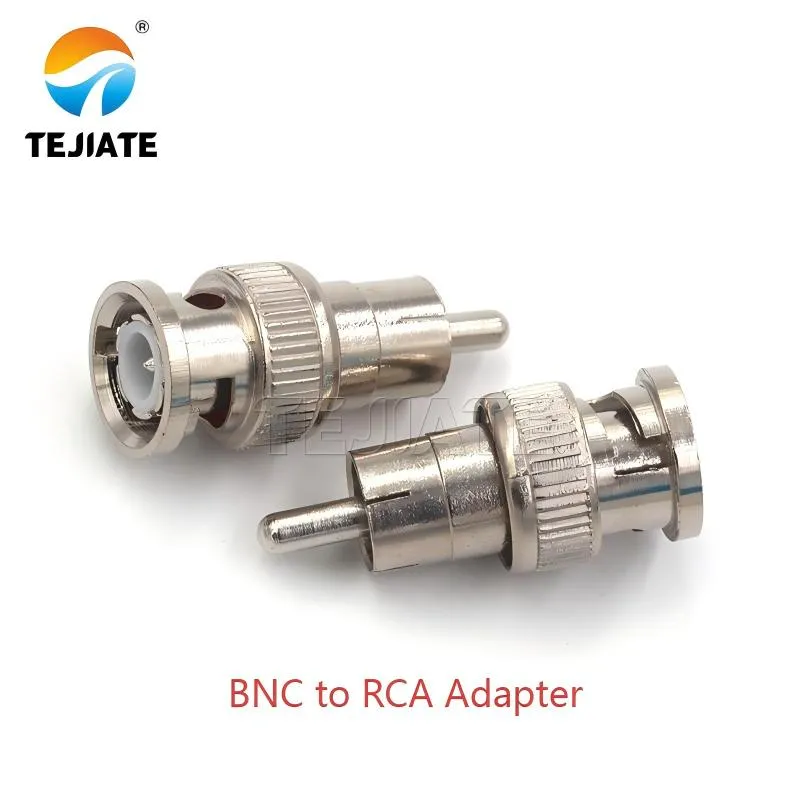
Based on the technical description of BNC and RCA interfaces at the beginning of the document, this diagram clearly compares the mechanical structure differences between bayonet-style BNC connectors and 3.2mm pin-and-sleeve RCA interfaces, providing visual reference for selecting the correct adapter direction
Every engineer who has ever connected a CCTV camera, a signal analyzer, or a network tester knows the small frustration that comes when two worlds meet — BNC and RCA.
One side uses a bayonet-style 50 Ω or 75 Ω connector, built for precision RF and video work; the other, a 3.2 mm pin-and-sleeve RCA jack, common on consumer displays and DVRs.
When you try to bridge them, impedance, signal level, and gender direction all start to matter.
At TEJIATE, we’ve spent years manufacturing BNC and RCA adapters rated up to DC–6 GHz, built from nickel-plated brass with gold-plated copper pins, PET insulation, and RoHS-certified reliability.
Whether you’re extending a coax run, matching a camera output, or diagnosing a no-signal feed, choosing the correct bnc to rca adapter isn’t just convenience — it’s about preserving every decibel of clarity.
Which BNC→RCA direction and genders do you actually need?
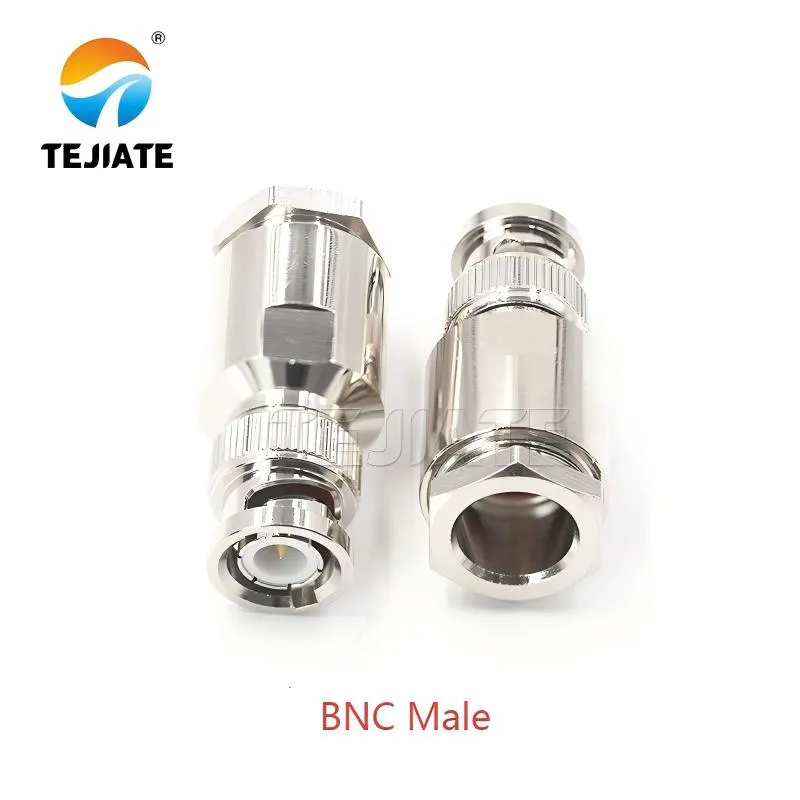
This diagram details the mechanical characteristics of BNC male connectors, emphasizing its unique rotating locking mechanism and center pin design, helping users accurately identify connector types to ensure proper matching
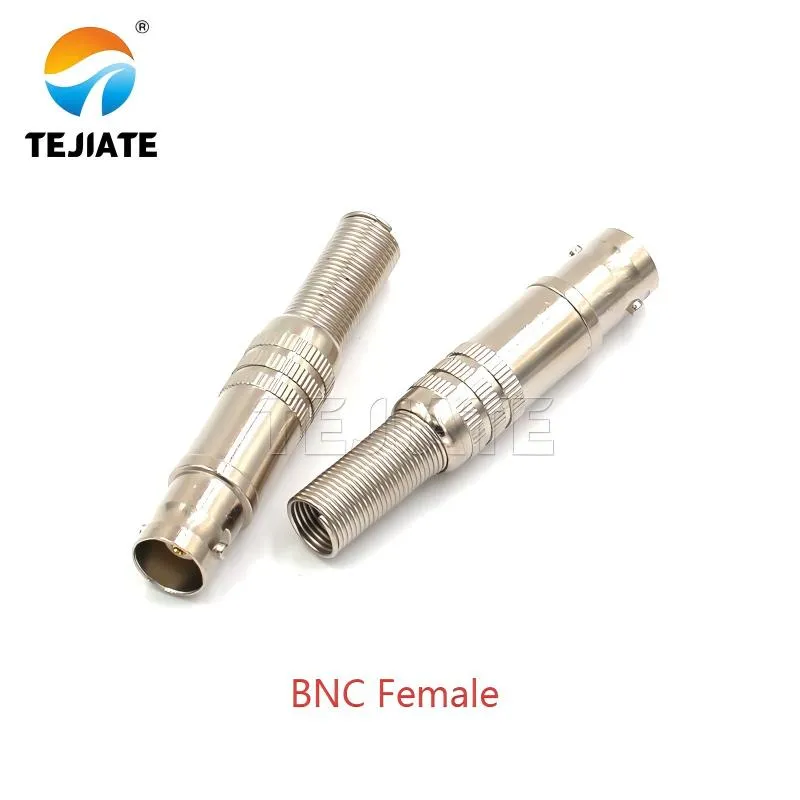
This diagram reveals the internal structure of BNC female connectors, focusing on the locking slots for receiving male lugs and the center socket, providing key technical details for understanding the complete BNC mating mechanism
a BNC female has the locking slots and center socket.
RCA connectors are simpler — the male is a pin, the female is the sleeve.
When adapting, your chain might look like this:
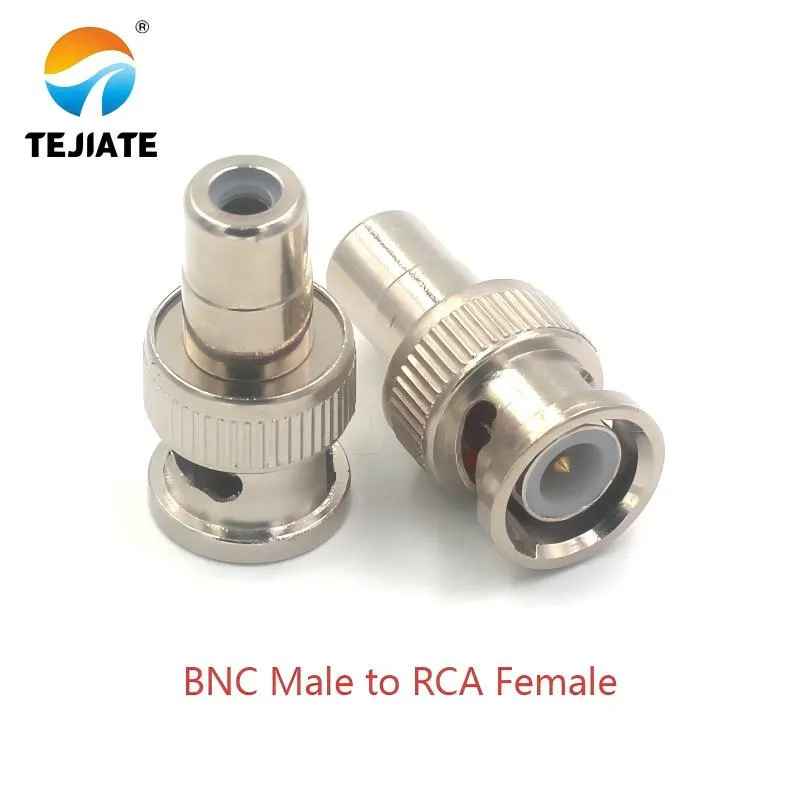
This diagram shows the most commonly used adapter type in the document, illustrating its typical application through clear interface labels: connecting cameras with BNC male outputs to monitors with RCA female inputs while maintaining 75Ω impedance matching
- BNC male to RCA female — most common when a camera has a male BNC output and the monitor has an RCA input.
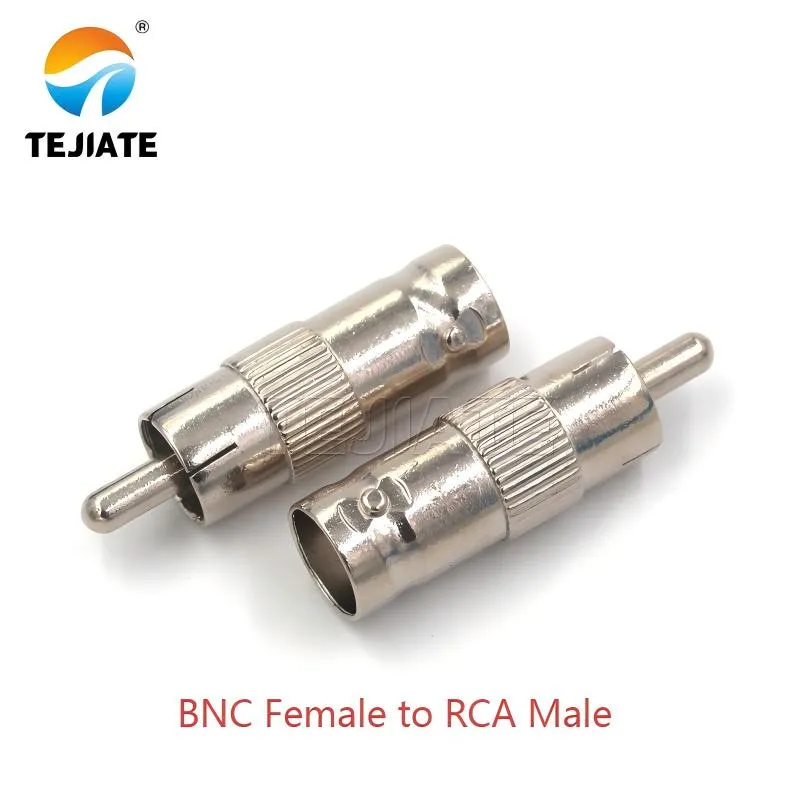
This diagram illustrates the typical application of another common adapter direction, when the video source has a BNC female interface (such as test panels) and the receiving end is RCA female, this adapter can complete the signal bridging
- BNC female to RCA male — used when the video source has a female bulkhead (like a test panel) and the receiving side is RCA female.
- Occasionally, a BNC female–female coupler (like TEJIATE’s BNC-KKY) bridges two male BNC plugs before stepping down to RCA.
These adapters are usually rated 50 Ω or 75 Ω, depending on your system.
For video applications, always pick 75 Ω parts — mixing 50 Ω and 75 Ω introduces reflections and ghosting.
TEJIATE’s brass-nickel adapters maintain full-surface contact, giving up to 1000 V dielectric strength and 500 insertion cycles, perfect for repeated CCTV use.
Should you use a simple adapter or an active converter?
Not every signal can survive a straight mechanical transition.
A bnc to rca adapter only passes the physical connection — it doesn’t translate formats or voltage levels.
That distinction decides whether you need a simple plug or a powered bnc to rca converter.
Here’s the rule of thumb:
| Signal Type | Impedance | Can Use Passive Adapter? | Notes |
|---|---|---|---|
| Analog CVBS (Composite Video) | 75 Ω | Yes | Direct BNC to RCA OK – same format & impedance |
| SDI (Serial Digital Interface) | 75 Ω | No | Needs digital SDI→AV converter |
| HDMI / Component YPbPr | 100 Ω diff. | No | Requires active decoder |
| RF-Modulated (TV antenna) | 75 Ω | Conditional | Needs demodulator or tuner input |
| Audio Line (RCA) | 10-50 kΩ | Avoid | Signal levels differ; noise likely |
If your system carries CVBS — the classic yellow RCA video feed — a direct adapter works perfectly.
But if your camera or DVR uses SDI or HDMI, you’ll need an active converter that handles format and signal level shifts.
For mixed setups, check the signal type in your device manual before forcing the plug fit.
A wrong connection can show rolling images, sync loss, or silence — not damage, but confusion.
For advanced readers, you can explore adapter vs converter signal loss in TEJIATE’s related BNC Extension Cable Length & Loss Guide — it explains how each mated pair contributes to insertion loss in multi-adapter chains.
How do you keep 75-ohm continuity from camera to monitor?
This is where most video-quality issues begin.
Even if both ends seem to work, mismatched impedance quietly eats away your signal integrity.
Below is TEJIATE’s simplified Adapter/Converter Decision Tree + Impedance Gate for maintaining a pure 75 Ω chain:
| Input Field | Example Value | Decision / Action |
|---|---|---|
| Signal_Type | CVBS (composite) | Adapter OK |
| Signal_Type | SDI / HDMI / RF | Converter required |
| Source_Z | 50 Ω (lab instrument) | Add 50 to 75 Ω matching pad (~5.7 dB loss) |
| Source_Z | 75 Ω (camera) | Direct connect |
| Dest Interface | RCA input | Adapter OK if 75 Ω |
| Needs_Power | Yes (digital) | Use active converter |
When using a 50 Ω BNC source with a 75 Ω RCA input, reflections occur.
The reflection coefficient Γ = (ZL − Z0)/(ZL + Z0).
For example:
Γ = (75−50)/(75+50) = 0.2 → Return Loss RL = −20 log10|Γ| ≈ 14 dB.
That’s a visible ghost on screen at higher frequencies.
So, you either insert a matching pad or use a 75 Ω camera feed directly.
TEJIATE’s precision 75 Ω connectors and RG59 coax preserve flat response up to 4 GHz, keeping VSWR ≤ 1.15 and insertion loss ≤ 0.15 dB per joint, as confirmed in the BNC 50 Ohm vs 75 Ohm Selection Guide.
Do you need a bnc to rca cable instead of stacking barrels?
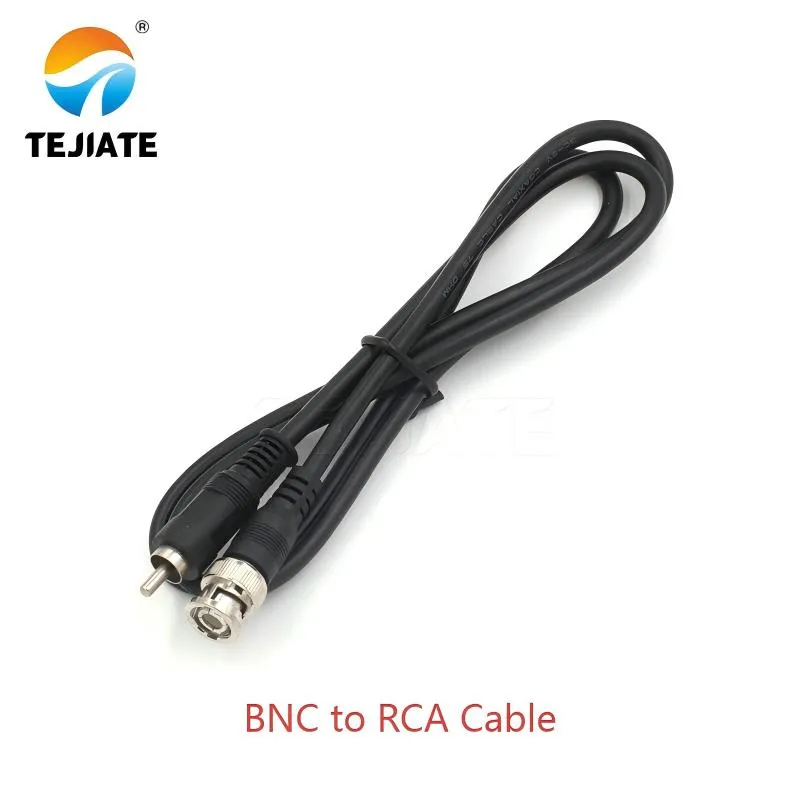
This diagram shows an optimized solution alternative to stacked adapters - pre-terminated integrated cables that maintain shielding continuity and impedance consistency by eliminating additional connection points, especially suitable for permanent or outdoor installations
You can’t fix every connection problem with another metal barrel.
Stacking multiple adapters — BNC couplers, RCA joints, or gender changers — might seem harmless, but every interface adds 0.1–0.2 dB of insertion loss and a little uncertainty in impedance.
That’s why, for permanent or outdoor use, a bnc to rca cable is usually the smarter choice.
A single pre-terminated jumper eliminates extra joints, keeps shielding continuous, and avoids those “wiggle until the picture returns” moments every technician has lived through.
TEJIATE’s brass-bodied BNC-RCA assemblies, made from RG59 or mini-RG59 75 Ω coax, deliver full continuity from camera to DVR input without adding mismatch points.
For racks, use panel-mount BNC female connectors (such as TEJIATE BNC-KY) and run an RCA jumper from there — it keeps service access clean and traceable.
And for outdoor or mobile systems, choose a jacket with PVC + PET insulation and proper strain relief to resist pulling and vibration.
If you’re not sure which configuration minimizes loss, the reference in TEJIATE’s BNC Coupler Selection Guide explains why too many mated pairs can compromise return loss even in short bench setups.
How do you connect a CCTV BNC camera to an RCA display step by step?
Let’s walk through a real installation using a 75 Ω CCTV camera and a standard monitor with RCA video in.
This process is straightforward, but each step avoids a common trap.
HowTo Checklist – BNC to RCA Connection for CVBS Systems
| Step | Action | Verification Field |
|---|---|---|
| 1 | Confirm signal type = CVBS (Composite Video) and system impedance = 75 Ω | Record Cam Z / Monitor Z values |
| 2 | Select adapter direction: BNC male to RCA female or BNC female to RCA male, depending on your camera and display ports | Check connector genders |
| 3 | Insert and twist-lock the BNC end gently (~ 0.8 – 1.0 N·m torque) | Note torque for maintenance |
| 4 | Push-fit the RCA end securely until you feel firm contact | Check sleeve tightness |
| 5 | Power on devices; verify picture stability and color burst | If no video, try a 75 Ω pad or active converter |
This checklist covers what most installers miss — identifying the right gender pair and checking for loose RCA sleeves that cause intermittent sync drops.
Always handle connectors by the shell, not the cable, to prevent mechanical strain on the crimp joint.
A good bnc to rca adapter like TEJIATE’s nickel-plated series holds contact pressure even after 500 cycles of insertion.
Can a 50-ohm BNC source be adapted to RCA safely?
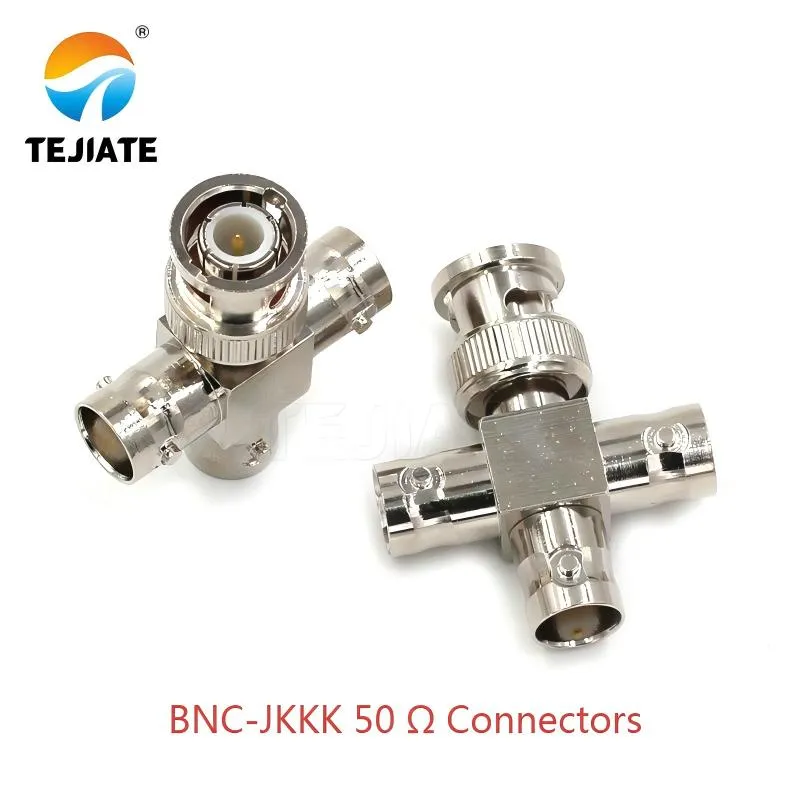
This diagram focuses on the technical considerations when matching 50Ω BNC source equipment (such as laboratory signal generators) with 75Ω RCA input devices, emphasizing the importance of impedance matching pads in eliminating signal reflections and ghosting
Sometimes you’ll face this in the lab: a signal generator with 50 Ω output, but your capture card or monitor expects 75 Ω via RCA input.
Yes, you can adapt it — but you’ll pay a small price in level.
The proper way is to use a 50 to 75 Ω matching pad, which introduces around 5.7 dB attenuation while eliminating reflections.
Without it, the reflected power causes standing waves and visible ghosts on screen.
Mathematically, the mismatch ratio is 1.5:1 VSWR, corresponding to about 14 dB return loss, the same figure used earlier in the impedance-gate example.
If you only need a quick visual test, a straight bnc to rca adapter can work — the signal may look fine for low-frequency CVBS (below 10 MHz), but on a high-bandwidth scope or SDI feed, you’ll see ripples.
For anything mission-critical, use a pad or re-terminate your coax to 75 Ω.
TEJIATE’s precision BNC-JKKK 50 Ω connectors (rated DC–4 GHz, 1000 V , −45 °C to +125 °C operation) ensure the source end stays stable even when temporarily linked to 75 Ω loads.
These mechanical tolerances and plating stacks are the small details that keep professional gear running quietly year after year.
If you’re adapting test equipment or RF analyzers, the SMA to BNC Adapter Lab Integration Guide explains how to maintain impedance consistency before transitioning to video connectors like RCA — an often-missed detail in hybrid setups.
What cable choices minimize noise and ghosting?
If your video chain looks fine but faint ghosts trail behind moving images, blame the cable first, not the adapter.
Cable impedance consistency matters as much as connector type. A 75 Ω coax, such as RG59, RG6, or TEJIATE’s mini-RG59 assemblies, keeps reflections low and bandwidth high — essential for CVBS and HD-SDI links alike.
Using a 50 Ω cable in a 75 Ω path shifts the reflection coefficient (Γ = 0.2) and yields a return loss of 14 dB, the same mismatch discussed earlier.
In TEJIATE’s own builds, every bnc to rca cable maintains under 0.15 dB insertion loss per joint at 4 GHz, with PET insulation that resists heat up to 125 °C.
For longer CCTV runs, pick copper-braid shields and PVC jackets that tolerate bending without fracture.
Avoid low-cost “audio-video combo cords” that mix 50 and 75 Ω conductors; they cause high-frequency ripple and visible ghosting even on analog feeds.
Keep the ground side continuous — don’t tie multiple grounds through splitters. Each additional ground introduces loop current that shows up as hum bars across the screen.
If you need to extend a line, the BNC Extension Cable Length & Loss Guide outlines how attenuation accumulates per meter so you can calculate a safe margin before the image starts to blur.
How do you test level and continuity after adapting?
Once your bnc to rca adapter is installed, don’t just trust your eyes — verify both signal level and grounding.
Start with a continuity test: ensure center pin to center pin connects cleanly while shields remain isolated.
If your multimeter beeps across shield and pin, you have a shorted RCA socket — replace it.
For performance verification, feed a SMPTE color-bar pattern or a 1 V p-p test signal through the adapter.
Measure at the display end with an oscilloscope or video level meter; the waveform should stay within ±10 %.
TEJIATE’s BNC connectors, built from nickel-plated brass with gold-plated copper contacts, maintain consistent contact resistance across 500 insertion cycles, ensuring level readings stay stable over time.
If you have access to a return-loss meter, measure reflection at 5 MHz and 10 MHz: anything better than −20 dB RL is healthy.
Even a simple field test helps — plug in a pattern source and observe the vertical edges. Crisp, ghost-free lines confirm impedance continuity.
What mistakes cause hum, ghosting, or no picture?
Most video dropouts trace back to just a few repeat offenders.
Here’s what typically goes wrong when using a bnc to rca converter or passive adapter:
- Mixed impedances — using a 50 Ω BNC on a 75 Ω RCA chain without a pad causes reflections and ghosting.
- Wrong gender or direction — forcing a bnc male to rca male combination with an extra coupler adds unnecessary joints.
- Stacked adapters — each adds small mismatches; combine three and you’ll see ghost shadows even on short cables.
- Poor crimps or loose RCA sleeves — intermittent ground contact creates flicker or full signal loss.
- Using an “adapter” when a true converter is needed — analog CVBS is fine; SDI/HDMI is not.
A clean signal chain should always read as a single 75 Ω path from source to display.
You can verify this visually with a multimeter or, better yet, by referencing TEJIATE’s 50 Ohm vs 75 Ohm Impedance Matching Guide; it explains how a mismatch reflects energy and degrades your color burst.
When do brand tolerances and plating matter for longevity?
At first glance, a bnc to rca adapter looks like a commodity part—two ends of metal joined by a barrel.
But long-term users know that brand-level tolerances decide whether your signal stays clean after a year of field work or starts to hiss and flicker.
A high-quality adapter like those from TEJIATE uses nickel-plated brass housings for corrosion resistance and gold-plated copper pins to maintain low contact resistance over hundreds of cycles.
The insulation is PET, stable up to 125 °C, and the entire assembly is RoHS compliant.
Even minor differences in pin depth or dielectric centering can shift impedance by 2–3 Ω, enough to disturb return loss on 4 GHz lines.
Many cheap imports lack full plating or use iron contacts that oxidize, raising contact resistance to the point where video edges smear.
For reliability, always check manufacturer data—500 mechanical insertions, 1000 V dielectric strength, and published impedance ratings show attention to RF detail.
A consistent mating feel (no wobble or tilt) usually signals correct bayonet geometry.
In short: the adapter that feels right under your fingers tends to measure right, too.
How should you document the hookup for future service?
Once your setup works perfectly, take five minutes to document it.
Label every cable and adapter with its impedance (50 Ω or 75 Ω) and signal direction—for example, “Camera → Monitor / CVBS 75 Ω.”
If you’re maintaining multiple racks, make a diagram of the adapter chain showing where each bnc to rca converter or coupler is placed.
During service calls, clear labeling avoids the guesswork of “which yellow cable was video in?”—a detail that often costs more time than the parts themselves.
Use printed tags or color sleeves rated for −45 °C to +125 °C so they don’t fade or crack over time.
TEJIATE recommends storing your notes in a shared maintenance log.
Record connector type, cable length, impedance, and measured return loss (if tested).
This log becomes invaluable when upgrading from analog CCTV to digital systems later—your documentation tells future engineers exactly which adapters can remain and which must be replaced.
FAQs
1. Are RCA-to-BNC adapters truly 75 ohms?
Not always. True video-grade adapters are rated 75 Ω and maintain ≤1.15 VSWR. Many generic types are “unrated.”
For any camera-to-monitor path, pick 75 Ω parts such as TEJIATE’s nickel/gold-plated series.
2. How do I use a BNC male to RCA male adapter?
Check both ports first. If both are male, insert a female–female coupler or use a bnc to rca cable instead—fewer joints, fewer headaches.
3. What’s the best RCA-to-BNC adapter for reliability?
Look for nickel-plated brass housing, gold contact pins, and a published return loss spec.
TEJIATE parts rated DC–6 GHz consistently outperform no-name units in bench life tests.
4. Can BNC be adapted to RCA without a converter?
Yes—only for analog CVBS 75 Ω signals. For SDI, HDMI, or RF-modulated feeds, use an active converter with proper format and level translation.
5. Where can I find BNC-to-RCA adapters in stores?
Professional broadcast or test-gear suppliers carry them.
Check specs, not just price: impedance, dielectric type, and plating matter more than brand label.
6. Should I make a DIY BNC-to-RCA adapter?
Avoid it. Small alignment errors in pin depth or crimping cause signal intermittence.
A factory-machined adapter like TEJIATE’s costs little but saves hours of troubleshooting.
7. Do I need a matching pad when adapting from a 50-ohm BNC source?
Yes—use a 50 to 75 Ω pad for accurate matching (≈ 5.7 dB attenuation).
Skipping it may cause ghosting or level dips, as discussed in the BNC 50 Ohm vs 75 Ohm Guide.
Closing Notes
A bnc to rca adapter may look small, but it’s the handshake between precision and convenience.
Choose the right direction and impedance, use quality connectors like TEJIATE’s brass-nickel series, and avoid over-stacking couplers.
Keep your signal path purely 75 Ω from camera to monitor, and document every detail for the next technician.
If you treat your video chain with the same respect you give the image it carries, you’ll get a sharp, stable picture that lasts for years—no ghosts, no hum, no guesswork.
Bonfon Office Building, Longgang District, Shenzhen City, Guangdong Province, China

A China-based OEM/ODM RF communications supplier
Table of Contents
Owning your OEM/ODM/Private Label for Electronic Devices andComponents is now easier than ever.
